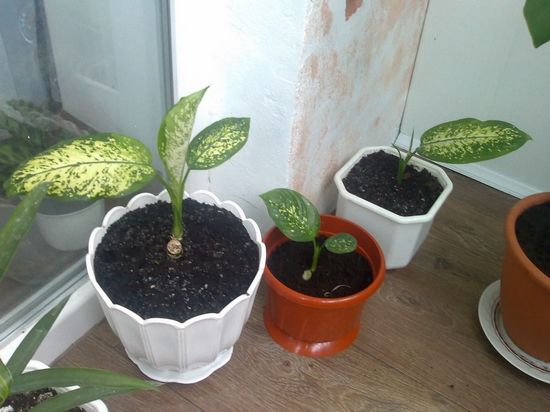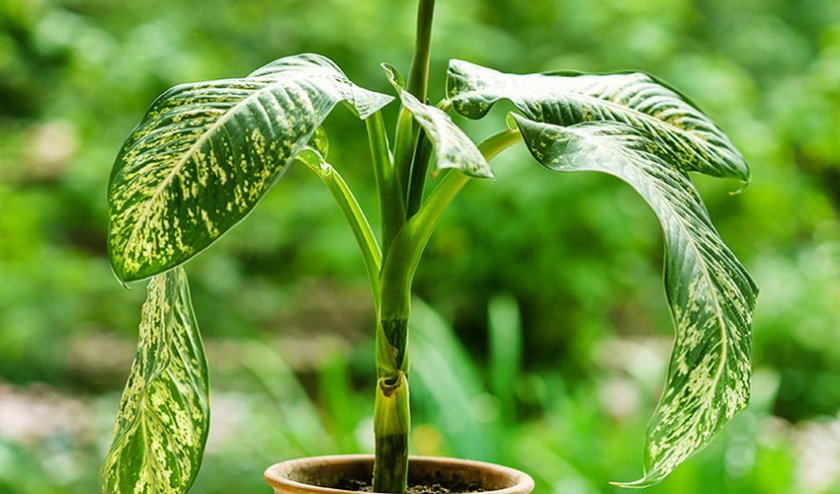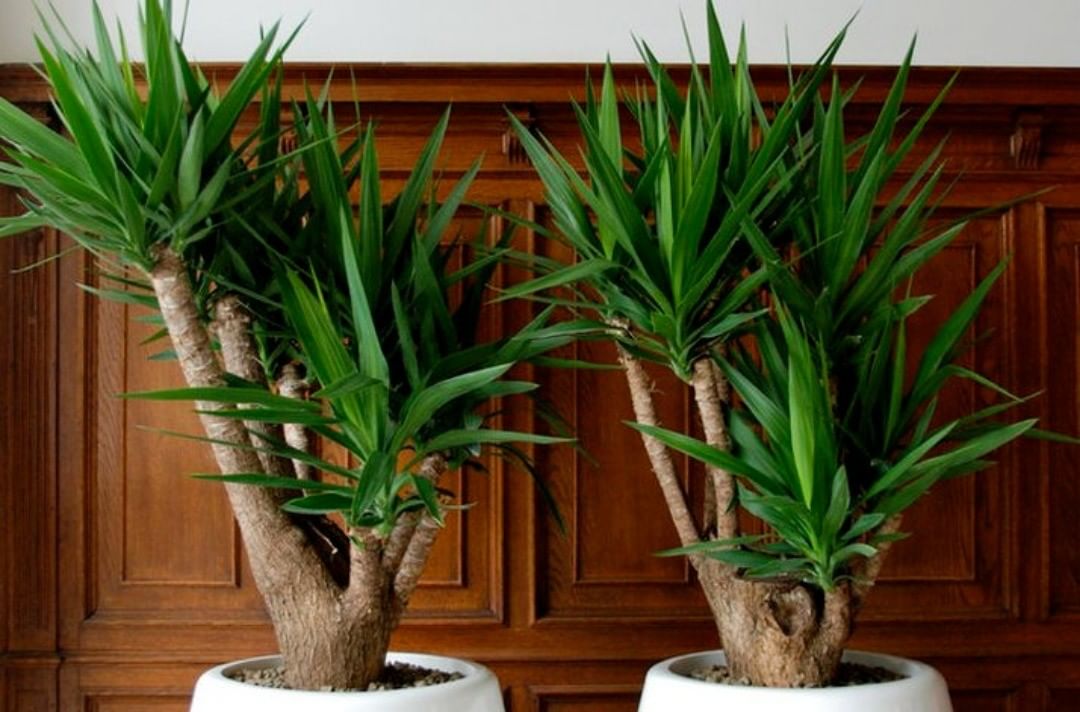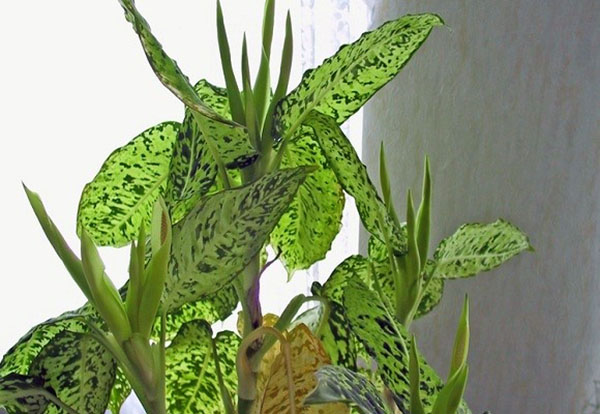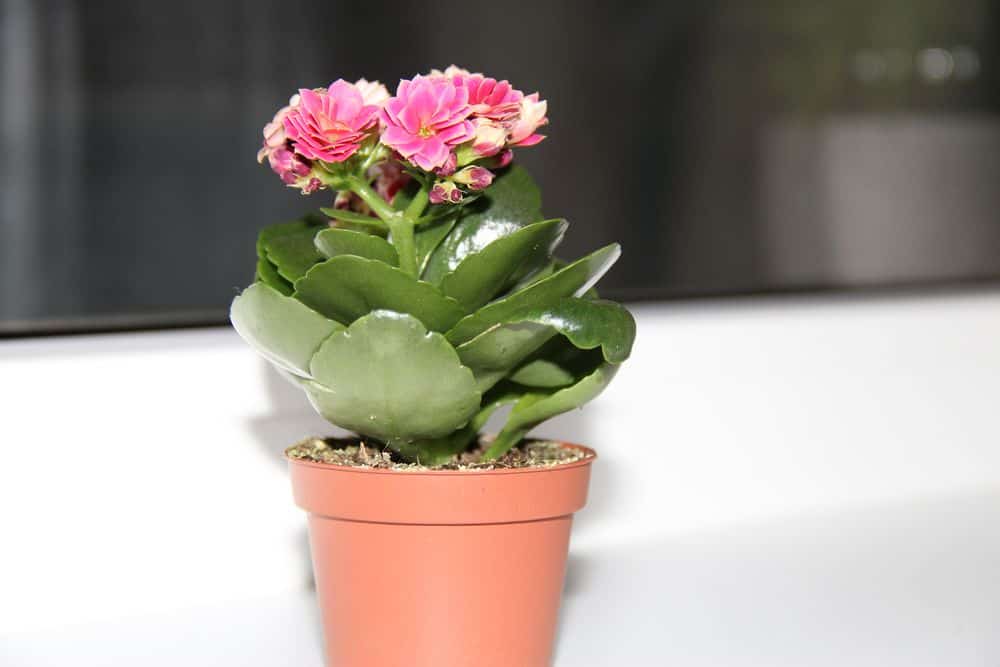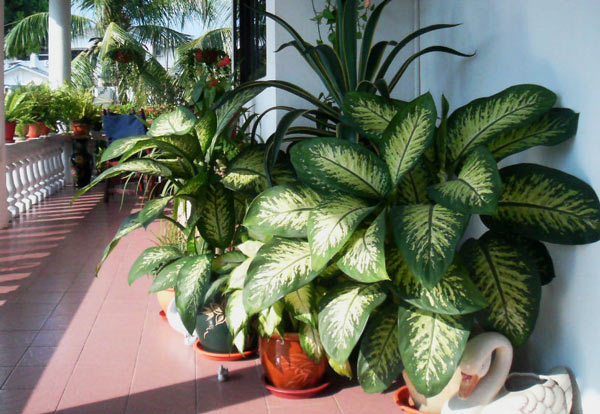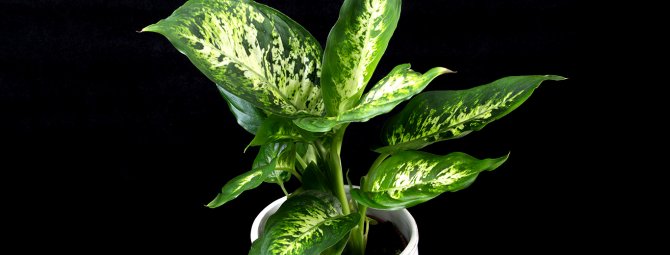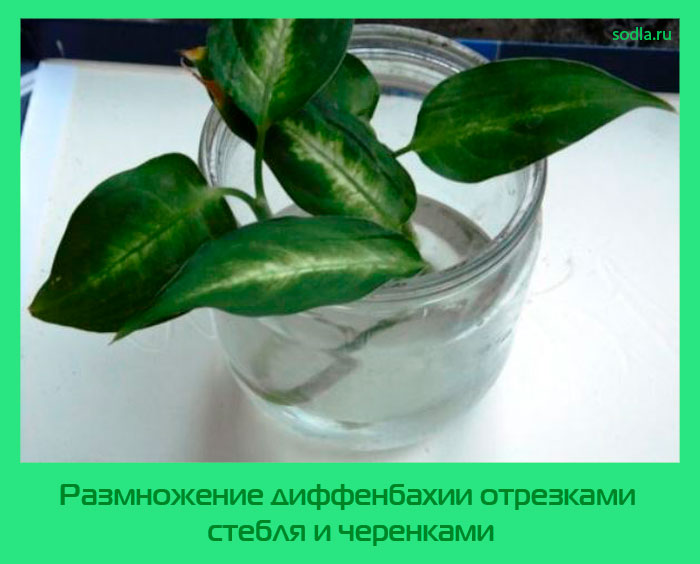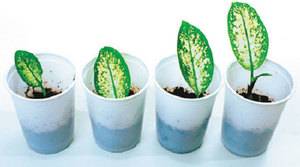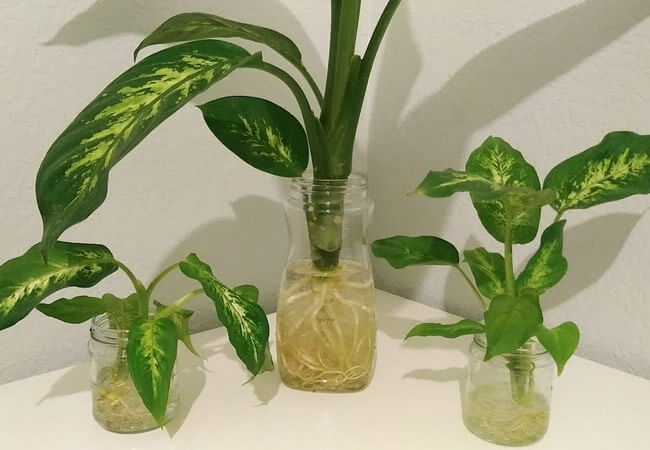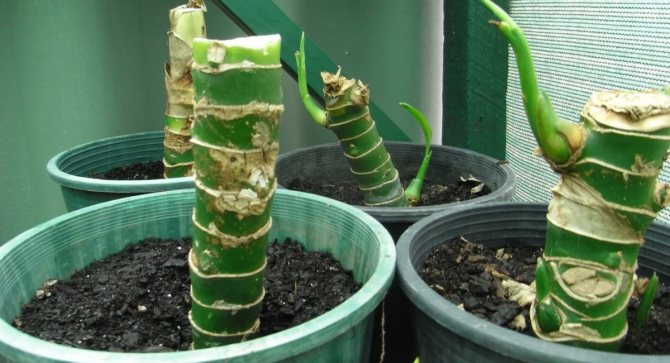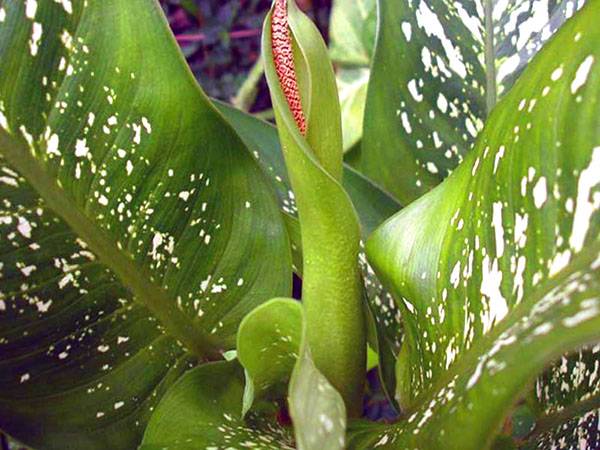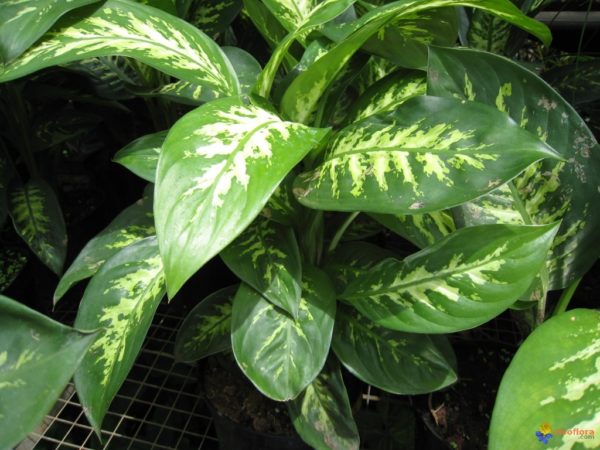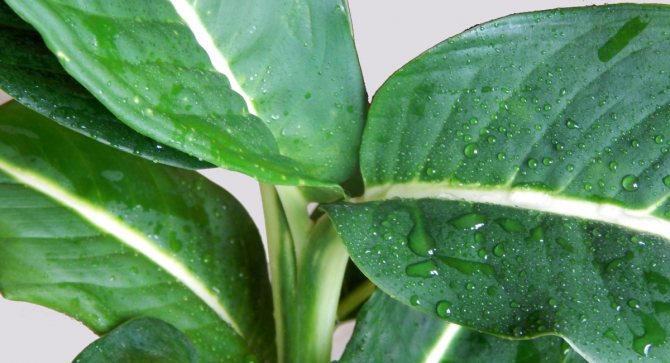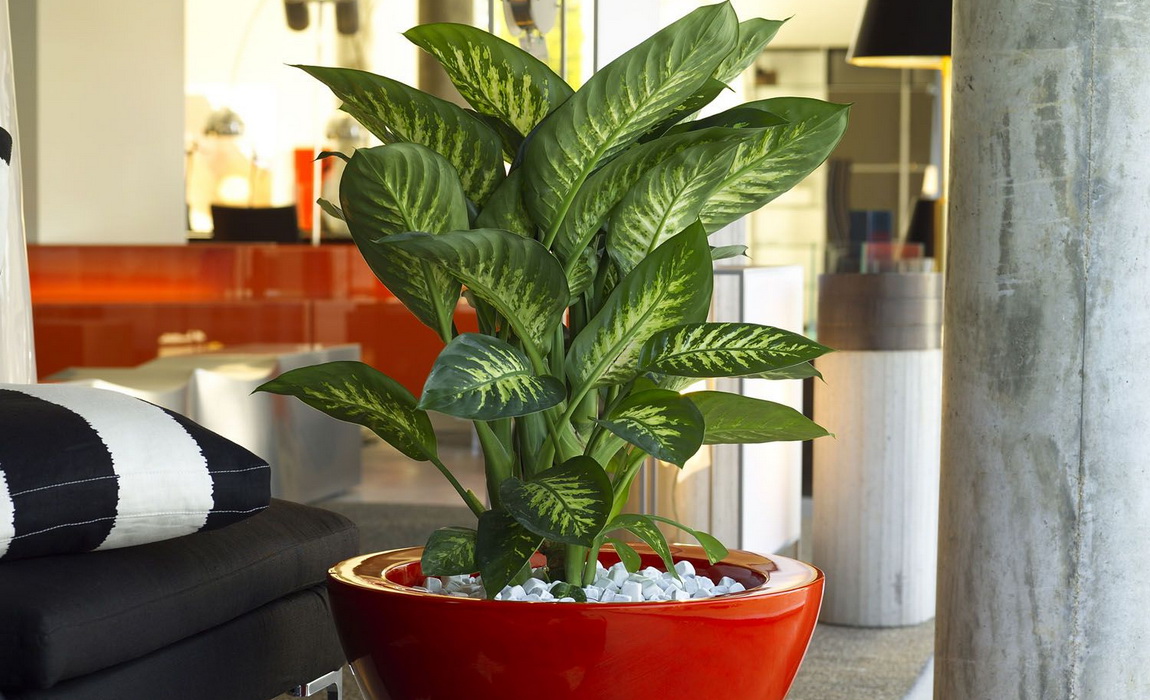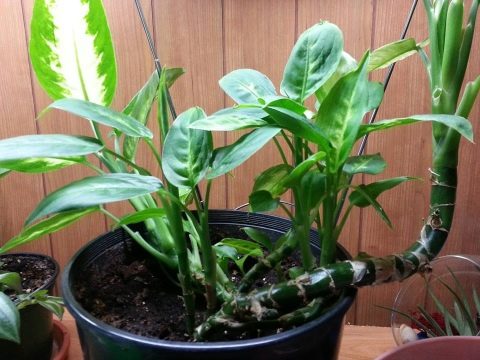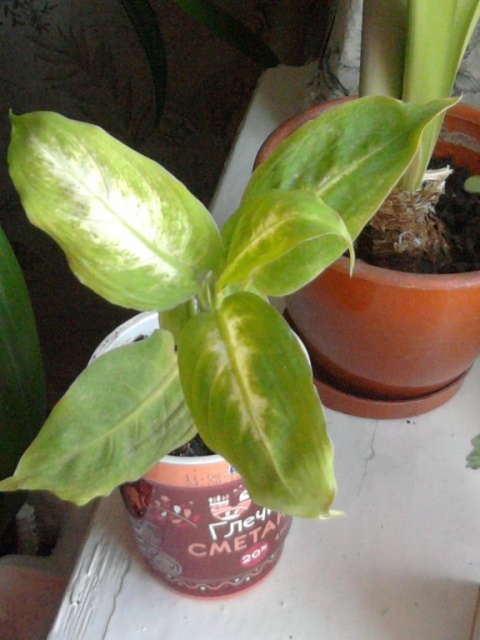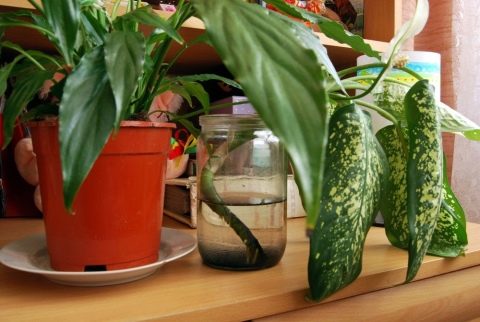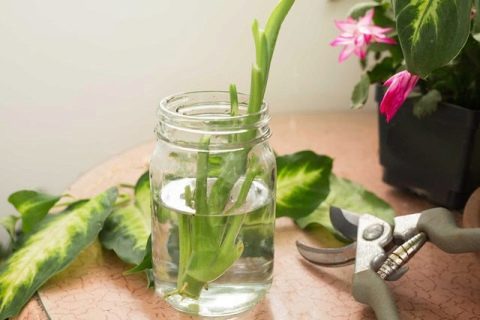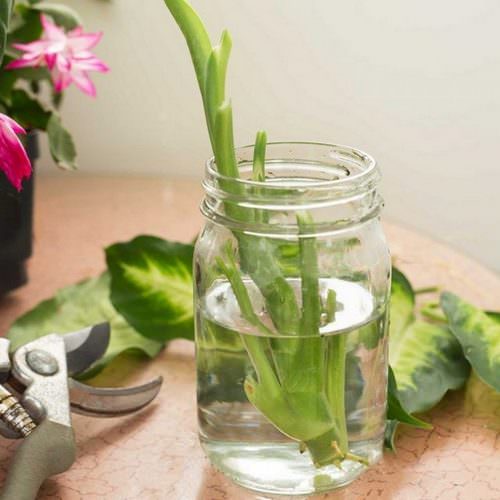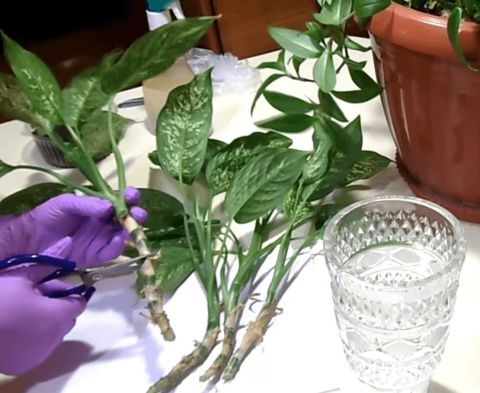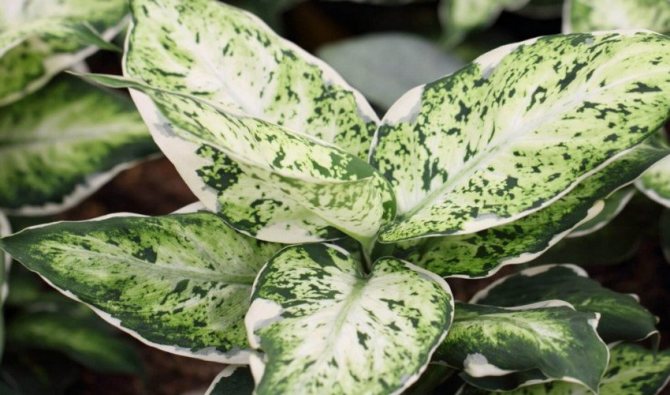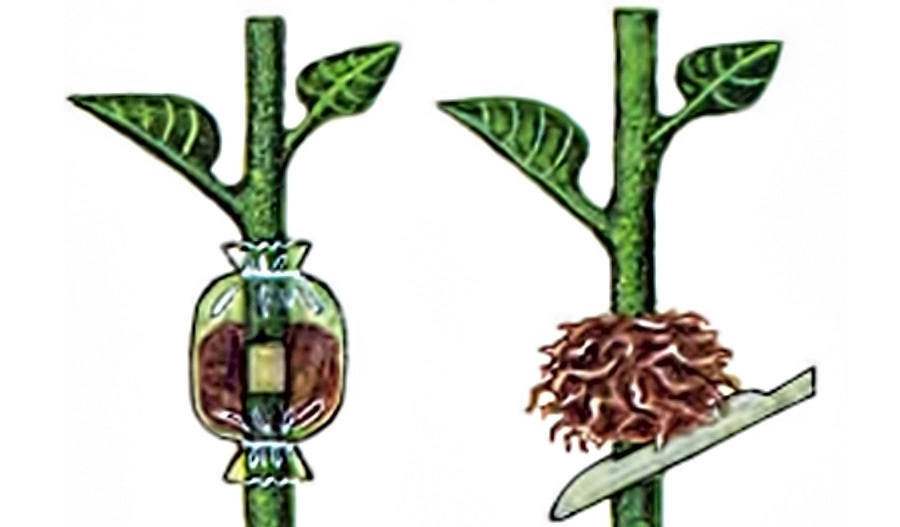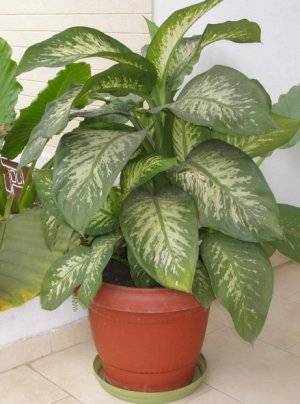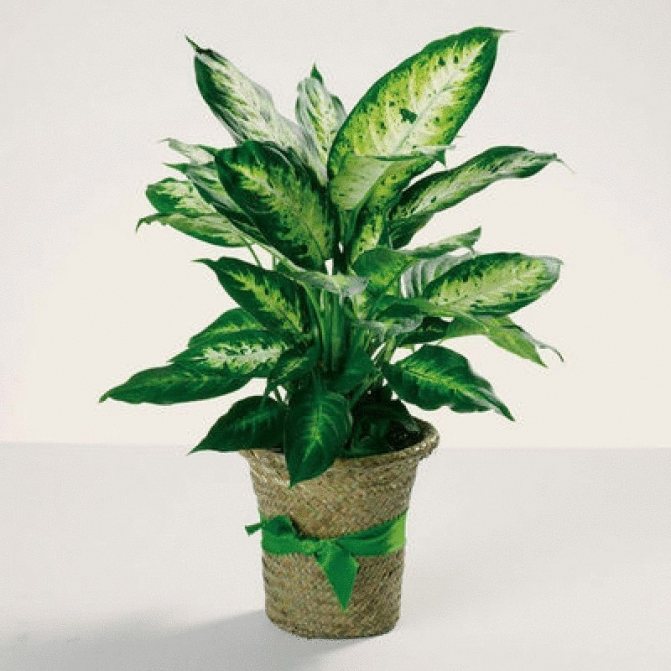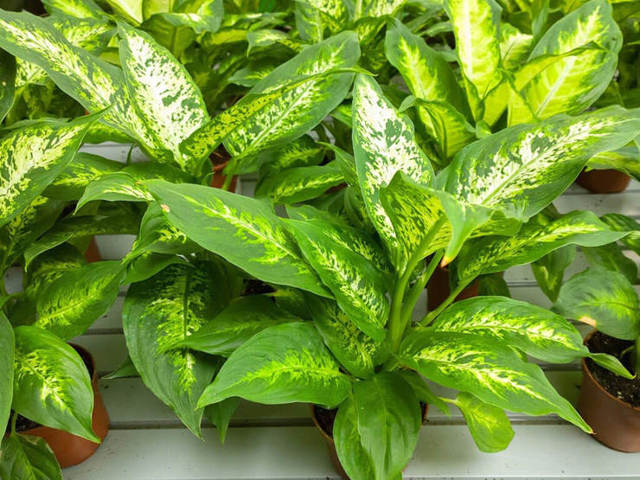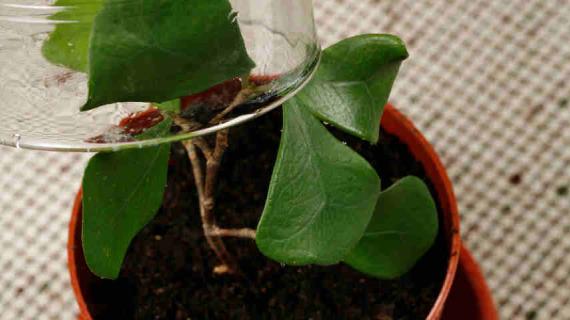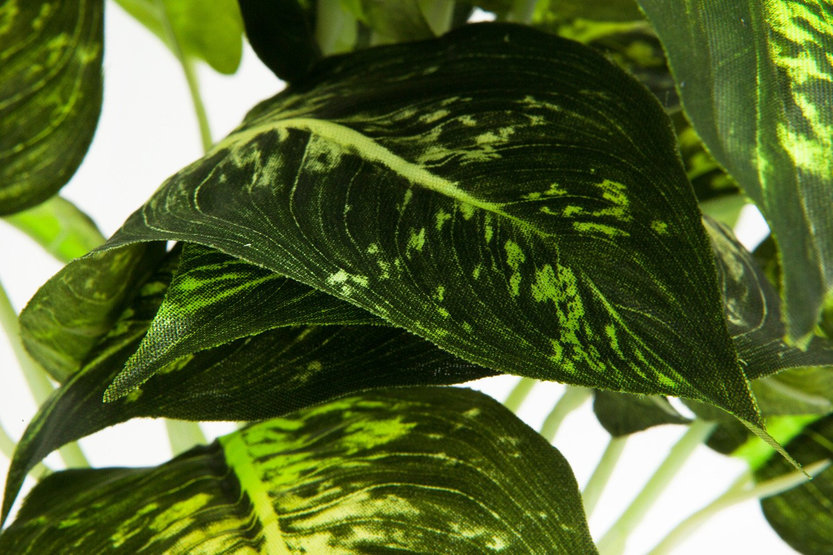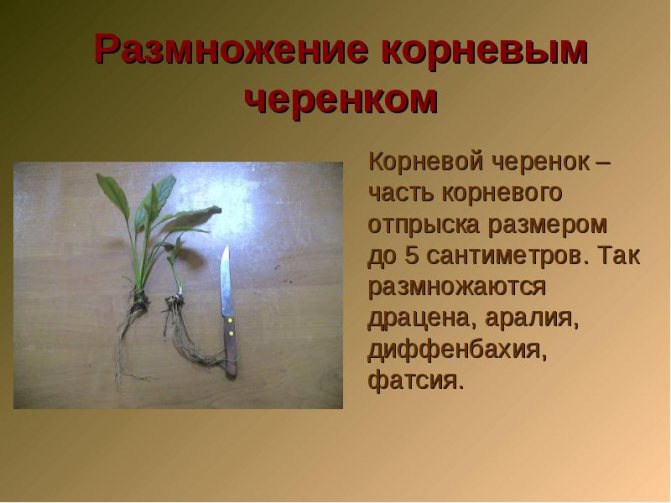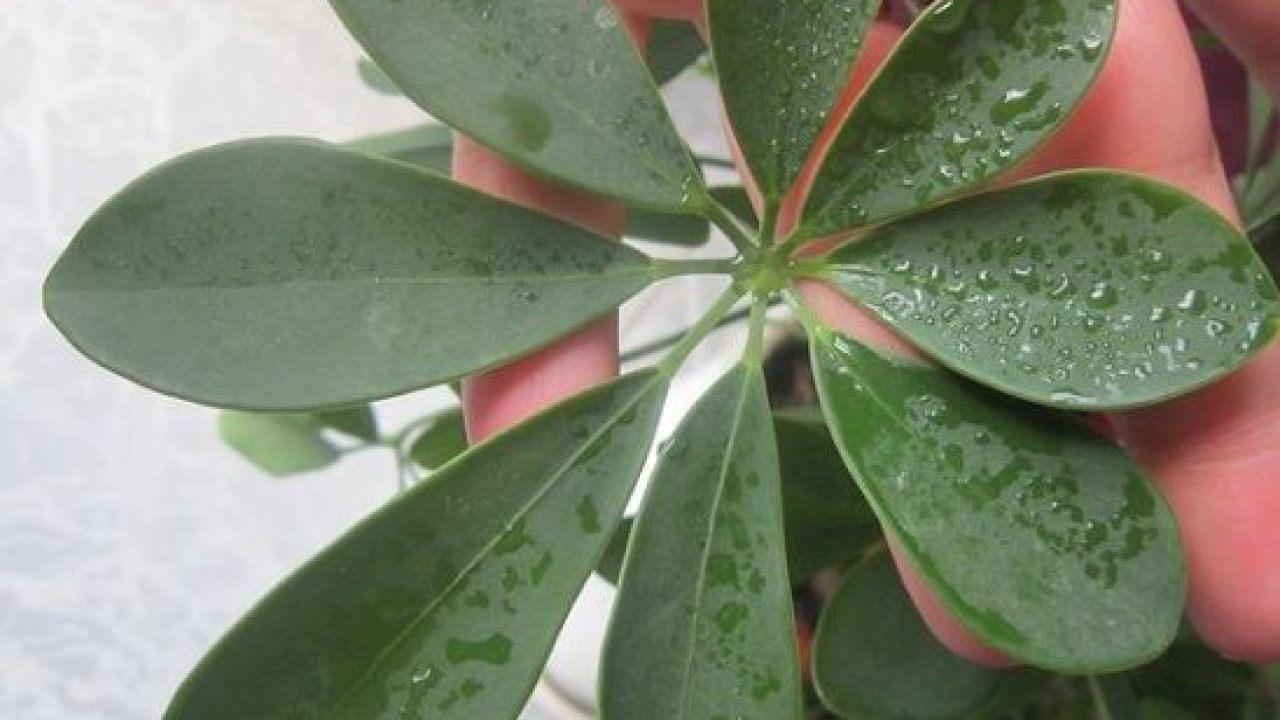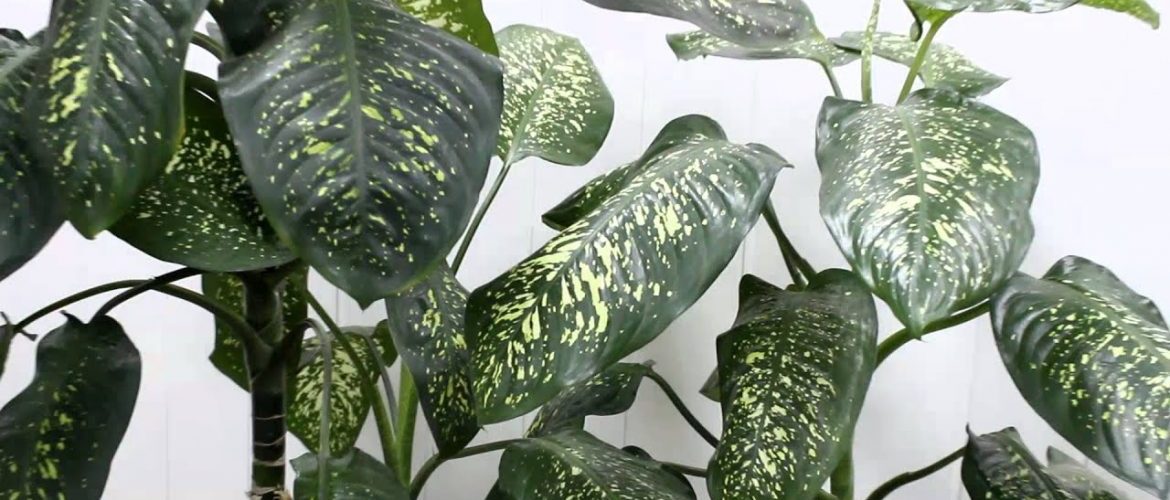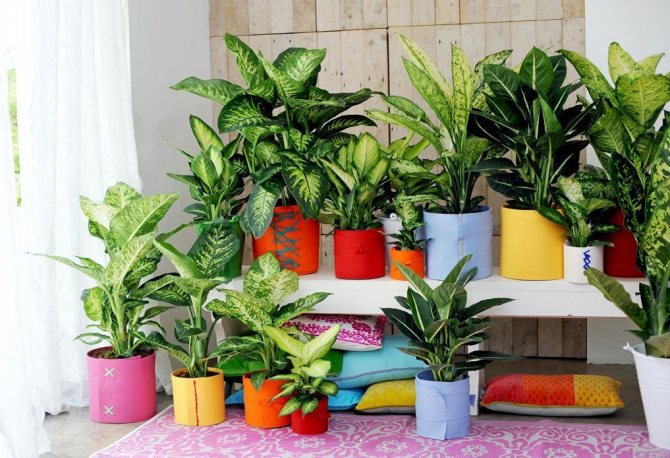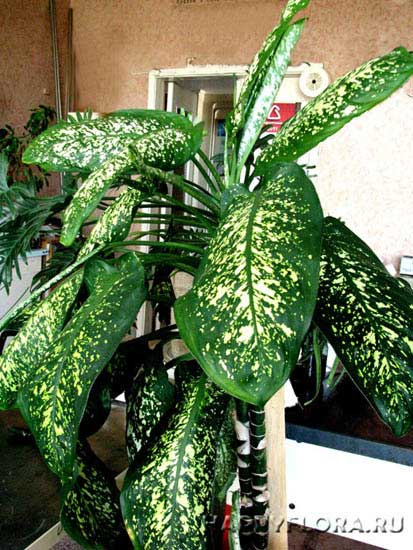Care of young plants
In the first year of life, young plants need special care. The rules are as follows:
- Dieffenbachia loves moisture, so watering should be abundant. However, it is necessary to ensure that the water does not stagnate, as excessive waterlogging will lead to decay of the trunk and roots.
- You need to place containers with flowers on the southern or eastern windowsill, protecting the plants from direct sunlight.
- Flowers need to be unwrapped regularly so that the trunk is straight and all parts receive the required amount of light.
- Once a month, dieffenbachia needs to be fed with mineral fertilizers.
- The plant responds well to spraying and warm showers.
- It is advisable to plant dieffenbachia in a rather voluminous pot, because the root ball grows very actively.
Growing and reproducing dieffenbachia at home is an exciting process. This "tropicana" grows quickly, variegated decorative leaves appear one after another. Therefore, all lovers of indoor flowers should have this amazing and cute plant on their windowsill.
The drug Heteroauxin: instructions for using the solution
We grow new specimens
Dieffenbachia propagation occurs in the spring, as well as at the beginning of summer. Autumn and winter cuttings root poorly. Stem cuttings root better in soil, and apical cuttings in water. The easiest and most reliable method for propagating dieffenbachia at home is with stem cuttings taken from the middle of the trunk. This material can be easily rooted by any method.
Soil for planting rooted cuttings can be made at home, or you can buy a universal soil with sand, vermiculite and peat. The pot must have a drainage of expanded clay or small stones.
You can take spacious dishes for planting dieffenbachia, its root system grows very quickly and quickly fills the pot.
Dieffenbachia propagation is carried out in several ways: apical cuttings, apical cuttings, stem cuttings.
Apical cuttings
Reproduction by apical cuttings - how to root dieffenbachia? This is not at all difficult to do, the apical cuttings root very quickly in water or in the ground.
For rooting in water, cut off the apical stalk 15-18 cm long, and put it in a glass of water. 1-2 tablets of activated carbon can be added to the water, so that the water does not spoiled, and the cuttings did not rot. Roots on cuttings in water will appear within 1 month, when they grow up to 2-3 cm, the cuttings can be planted in the ground.
For rooting in the ground, the cut point of the cutting is treated with activated or charcoal powder, after which it is deepened into the ground and covered with a jar, plastic bottle or film. You need to air the cutting regularly, watering is carried out every 2-3 days. With this rooting method, the roots will appear after 2 months, when young leaves begin to appear on it, the stalk is transplanted into a permanent pot.
Stem cuttings
Propagation by stem cuttings is another method that can be used at home. In this case, the bare stem of an old plant that has lost its leaves is cut into cuttings. Cuttings-pieces should be 10-14 cm long. Stem cuttings are also carried out in three ways - in water and in the ground, as well as by laying them on the surface of the ground.
Rooting of stem cuttings in water occurs in the same way as rooting of apical shoots, roots appear after 3 weeks.The cuttings are transplanted into the soil after the roots get stronger.
The rooting of stem cuttings in the ground looks like this: the cuttings are placed in the ground with their lower end, deepening by 2 cm, covered with a transparent cover and placed in a warm place, constantly airing and watering. Rooting of cuttings will take place in 2 months.
When rooting cuttings horizontally, they are laid on the soil and slightly pressed into it. The container with cuttings is covered with a transparent cover, which is removed for watering and airing for several hours a day. When the cutting takes root, buds with shoots will begin to grow from the stem, resulting in a lush bush. After 1.5-2 months, the rooted cutting can be transplanted to a new place along with a lump of earth.
The stump that remains in the pot after the trunk has been cut into cuttings does not need to be thrown away. It needs to be watered and placed in a bright and warm place, after a few months young shoots will appear on it, and the plant will begin a new life.
Apical layers
Reproduction by apical layers. The process looks like this: several small horizontal cuts in the form of circles are made on the trunk, the cuts are covered with wet sphagnum moss, wrapped in plastic wrap, and then tied with ropes.
The moss must be kept moist at all times for the roots to grow back faster. When they appear, they can be seen through the transparent film. The apical stem is cut off along with the roots and planted in a separate pot along with the moss.
Caring for young plants should be the same as caring for adult specimens - they are watered twice a week with warm purified water, constantly sprayed, the leaves are wiped with a damp sponge.
Dieffenbachia growing at home is fed with nitrogenous fertilizers 1-2 times a month. This indoor flower grows quite quickly, so it has to be transplanted every year.
Rooting soil
As we already know, this decorative flower can be propagated by rooting cuttings cut from an adult plant. In order for the cuttings to give roots, they are placed in a nutrient medium - soil or water. In order for the cut trunks of dieffenbachia to acquire their own roots, place them in a container filled with water or earth.
The easiest way is to root the cuttings in water, for this:
- fill the jar with water and dissolve a couple of activated carbon tablets in it;
- to provoke the formation of a root system, place the cuttings in water;
- put a jar of water and cuttings in a bright, warm place with a temperature of 21 to 24 degrees above zero;
- so that fresh roots do not rot, periodically change the water to fresh. This procedure should be carried out at least once a week.
The first roots will appear approximately one to two weeks after the cuttings are placed in the aquatic environment. It will be possible to plant new plants in the soil only when the roots reach two to three centimeters in length.
To speed up the growth of the root system, you can add a few drops of aloe juice to the water. This common agave is able to activate the internal forces of dieffenbachia, which will lead to the rapid growth of roots and the awakening of dormant buds.
Nutrient substrate
It is possible to induce the growth of the root system in cuttings not only with the help of water, but also using nutrient soil. To do this, it is worth preparing a suitable soil, it should be lighter than the planting soil, which is used for the constant cultivation of flowers. We offer two soil compositions for rooting cuttings. First:
- 0.5 kg of peat soil;
- 500 g soil baking powder.
Second line-up:
- 250 g of peat soil;
- 0.5 kg of sphagnum;
- 250 g baking powder.
Use vermiculite or perlite as a loosening agent for the soil. The earth, prepared from such ingredients in the correct proportions, turns out to be very light, and most importantly, it is breathable.In such a substrate, young roots will quickly grow and can germinate through it.
To prevent the cuttings from starting to rot, which is a frequent occurrence when rooting in the soil, add crushed activated or charcoal to the soil.
Cut cuttings should be dried before placing in the ground, after which they can be buried in the soil. To do this, they are lowered into the ground to a depth of about four to six centimeters (two to three knots). In winter, the process of root formation may take a long time or not start at all if the cuttings start to rot. To accelerate the growth of roots at this time of year, it is recommended to place the cuttings for ten hours in a solution of "Kornevin" (heteroauxin) before planting. After that, they are planted in moist soil.
If your cuttings are small in size, and their length does not exceed 10-15 centimeters, then after deepening, you can organize a home greenhouse for them. To do this, cover the plantings on top with cans, foil or glass.
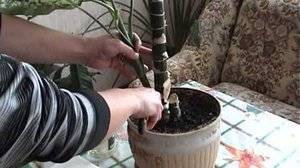 The cover of an improvised greenhouse must be transparent. This will provide the cuttings with high humidity and a constant temperature, that is, they will be in a greenhouse environment. This effect will provide cuttings with high rooting chances, which is especially useful in winter, when the plants are not tuned for vegetation and root growth. In the spring and summer, such tricks can be abandoned.
The cover of an improvised greenhouse must be transparent. This will provide the cuttings with high humidity and a constant temperature, that is, they will be in a greenhouse environment. This effect will provide cuttings with high rooting chances, which is especially useful in winter, when the plants are not tuned for vegetation and root growth. In the spring and summer, such tricks can be abandoned.
For rooting dieffenbachia, it is best to use loose soil and small, separate containers. Plastic cups or cut bottles are perfect for this.
It should be borne in mind that cuttings rooted in the soil require special care:
- correct watering. Until the branches have a root system, they should be watered very carefully, otherwise you can provoke rotting of the planting material. Therefore, consider the following rule - watering is done only when the soil around the buried cutting is dry;
- spraying. It is quite problematic for stems without roots to absorb moisture from the soil; through the foliage they do it more willingly. Therefore, once a day, plant leaves (if any) should be sprayed with plain water from a spray bottle. This procedure will help young Dieffenbachia get started with root growth and overcome the stress of transplanting.
Necessary conditions for plant propagation
Dieffenbachia is an indoor flower, for the reproduction of which it is necessary to create certain conditions in the house. First, you should choose the right time for this procedure. Breeding is usually done in spring or early summer. It is worth noting that a stalk harvested in winter does not take root for a long time. Moreover, it is impossible to speed up the process even with high-quality scion care.
It is possible to improve the survival rate of a plant by choosing the right soil. This indoor flower prefers light soils. You can also use a universal soil by adding a peat-sand mixture or vermiculite to it. Before filling the soil in the pot, you need to organize a drainage layer at the bottom. The container itself should be spacious, since dieffenbachia is distinguished by active growth and rather quickly fills all the space of the pot available to it. Growing this flower at home, you need to know that its juice is poisonous to animals and humans. Therefore, all manipulations with the plant should be performed with rubber gloves. After completing the work, hands should be thoroughly washed with soap. Also, when interacting with this home beauty, you need to protect not only the skin of the hands, but also the eyes along with the mucous membranes. Because of this feature, dieffenbachia must be grown out of the reach of children and animals.
Basic breeding methods
Some lovers of green plants are wondering how to propagate dieffenbachia at home. There are several methods:
- Seeds.
- Cuttings.
- Rooting of the apex.
- Rooting the leaf.
- Division (seating).
It should be borne in mind that reproduction with the help of seeds is a rather tedious and time-consuming process, moreover, it is impossible to guarantee the result. Rather, this method is suitable for specialists and breeders who develop new plant species. Therefore, at home, dieffenbachia practically does not multiply by seeds. The following methods are the most simple and effective:
Dieffenbachia propagation by a leaf. It is necessary to choose a strong, healthy and resilient leaf, take a sharp knife and disinfect it. Cut off the selected leaf and divide it into parts. Dry leaf particles on a balcony or terrace. Then they should be treated with a growth stimulant and placed in a light nutritious soil. Cover the pot with greenhouse film and place it on a well-lit windowsill. After fourteen days, roots will appear on the leaves. The particles can then be transplanted to a permanent location. For propagation, it is best to choose those leaves that are closer to the root, as they are stronger. This method cannot guarantee a 100% result, since young shoots can die for various reasons.
Dieffenbachia propagation by cuttings. Cutting dieffenbachia is best done in the spring. First, you need to cut off a piece of the plant's stem, about ten centimeters long, with two or three buds. Place the cutting in water for two weeks. During this time, small roots should appear. Transplant the cutting into a pot of nutritious soil, cover with a jar and place on a well-lit windowsill. For rooting to be successful, it is necessary to maintain a room temperature of about twenty-five degrees. After the seedling gets stronger, the jar can be removed. Cutting dieffenbachia is simple and easy. A fairly large amount of planting material can be obtained from just one stem.
Rooting of the apex. The flower grows quickly, so it happens that the lower part of the trunk is bare and the plant requires rejuvenation. In this case, tip propagation can be carried out: cut off the top of the trunk with several leaves and one bud. You need to root the cut cutting in one of two ways: place it in water or nutrient soil. A stalk placed in water will root in about ten days. After that, it can be planted in a container with earth. Dry the cut site before placing it in the ground. It happens that when rooting, dieffenbachia begins to throw off the leaves. There is no need to worry, so the plant gets rid of sources that consume energy, which is currently needed by the root system.
Division. An old and overgrown dieffenbachia bush can be divided into several parts. The process is simple and consists in the following: remove the main bush from the pot, shake the earth from the root ball
Carefully divide the bush into parts and plant them in different containers. Sprinkle soil over the root and tamp it a little. Water the plants abundantly with water at room temperature
Water the plants abundantly with water at room temperature.
Reproduction of this decorative leaf step by step
There are many reasons for breeding a flowerpot:
- he may need an update, since the old dieffenbachia over time will not only rest against the ceiling and begin to grow parallel to it, but will also begin to resemble a bare stick crowned with a bunch of leaves;
- your flowerpot may break;
- from one dieffenbachia you will need to make several for friends or for sale.
Below I will talk about the most popular household methods for breeding dieffenbachia. I will not talk about the seed method.
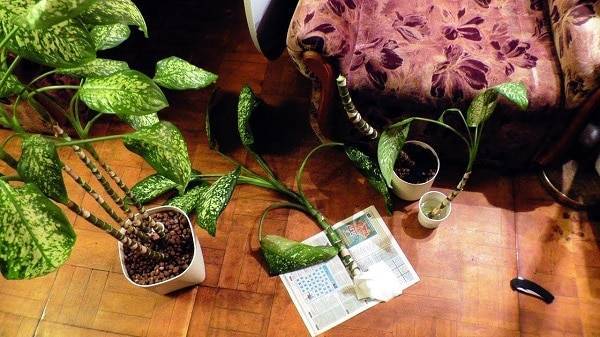
Firstly, we practically cannot get seeds, and secondly, this method is too long and unreliable. Only breeders who grow new varieties turn to it.
Rare types of bush dieffenbachia can also be propagated by dividing the bush. This is done when transplanting.
Apical cuttings
This is the easiest way - as well as the fastest, because the point of growth of such plants is located exactly at the top. Having rooted in this way, Dieffenbachia will grow a leaf every week, very quickly from a cutting into an adult plant.
Your actions:
- Cut off the top so that the stalk is 10 to 15 cm in size. You do not need to cut it longer - even if a large stalk releases the roots, it will be difficult for them to "feed" such a plant by extracting nutrients in the soil.
- Milky juice will begin to stand out from the slice. It needs to be removed. Some people wash the cuttings under the tap, others rinse the cut in a glass of water (changing the water as needed), and still others simply wipe it off with a few paper napkins. All options are correct.
- You can root the stalk as in a glass with clean (or mixed with an energy drink - succinic acid, "Epin") water, a wet mixture of peat and sand, moss. It is not necessary to deepen the cutting very much - 2-3 centimeters will be enough. Before rooting, the slice can be dipped in "Kornevin" - this tool accelerates the emergence of roots.
- Keep the cutting in a warm place (22-24 degrees), keep out of direct sunlight, spray often.
- If the cutting is in the water, you will not miss the emergence of roots. Let them grow up to 3 cm and you can plant the plant in your own pot.
- Do you grow dieffenbachia in soil? New leaves that will grow on top of the plant will signal the appearance of roots. If you saw such leaves, you can transplant the cutting into the ground more seriously.
Blot the stump from the emerging juice, and then seal it with wax from a burning candle (it will protect it from rot - however, this is not a prerequisite). Water the plant, and after a while, new tops (one, or even several) may sprout on the sides of the "seal".
Dieffenbachia can be left as is. But if it seems to you that the "stump" plant looks untidy, you can cut off all the grown tops and root.
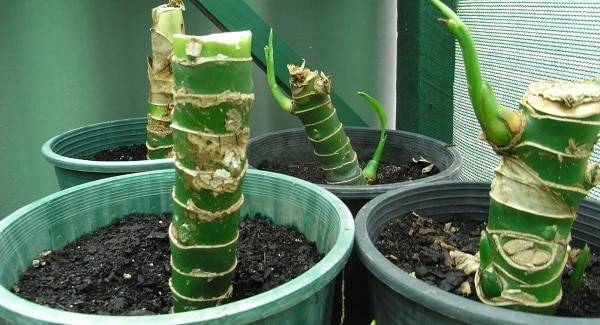
Stem cuttings
The bare trunk of Dieffenbachia will also be used.
It can be dried (washed) from the juice and used in two ways.
- Cut the trunk into cuttings about 10 cm. The main thing is that each has at least one internode. Dip them in Kornevin from the bottom (optional), seal them with wax from the top. Stick the lower part into water, wet moss, sand, sand + peat. Root them as described above.
- Lay the cuttings sideways in the ground (as in the photo above). If you see kidneys, make sure they are on top. Cover the pot with plastic wrap (transparent bag) and keep warm. In this case, you need about 25 degrees. The sprouts that have appeared on the cuttings will tell about the rooting of these processes. They can sprout in a row on this cutting.

Lateral processes
Most dieffenbachias only grow upward. But some species also have lateral buds. I show how they look in the photo above.
From here, over time, a shoot will appear. When it gets stronger, you can cut it off and root it like a cutting.
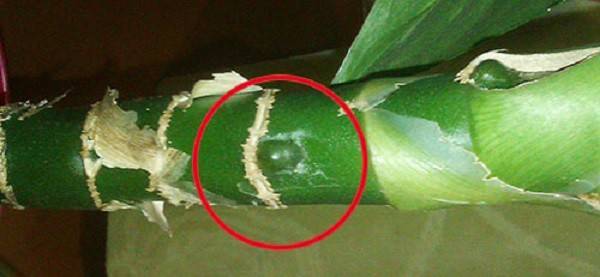
Air layering
Option for those who are addicted. He will also help out if you need to propagate the plant, and it is still too young - there is nowhere to cut the stalk.
Everything is done like this:
- Make a bark cut in the trunk in a circle.
- Cover the bare "wood" with moistened sphagnum, and wrap it with transparent film on top. If it doesn't hold, secure it with tape, tape, and so on.
- Have you seen the roots? You can cut off the top of the stem with these roots and plant it in a pot. Do not pick moss.
- Dry the lower part of the plant, you can seal up with wax.
By the way, you can propagate ficuses in the same way.

Reproduction of tree dieffenbachia
Reproduction of dieffenbachia apex
The trunk of dieffenbachia becomes bare over time in the lower part, and the leaves remain only at the top.Such a plant can be used to obtain several dieffenbachia at once, which will give a detached tip, a trunk divided into parts and a root with a hemp.
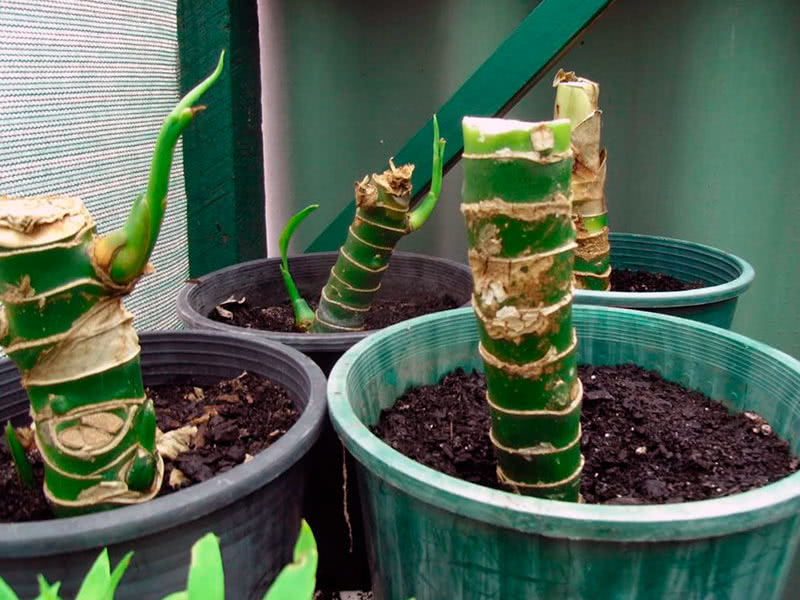
The apex is cut in such a way that the cut passes one and a half to two centimeters below the kidney. Then the apical stalk is cut into a container with water and an activated carbon tablet dissolved in it. But you can immediately plant the top in a mixture of sand and peat in equal parts. The optimum temperature for rooting is 22-25 ºC, and if the room is cooler, you will have to use bottom heating. A plant needs two weeks to two months to grow roots. When the roots have reached a length of 3-4 cm, the plant is transplanted into a pot with soil for dieffenbachia.
It is better to root the top during the time period from February to early summer.
Propagation of dieffenbachia by cuttings
The stem remaining from the plant is divided into cuttings 10-15 cm long, dried during the day, and then planted in a cuttings filled with a mixture of peat and sand, deepening the lower cut by 2 cm. The cuttings are covered with a transparent lid on top. You can arrange the cuttings in a mini-greenhouse horizontally, buds upwards, pressing them half the diameter into the moistened soil, and cover with a lid. After 2-3 weeks, sprouts will appear from the buds, and roots will begin to grow on the back of the segments into the substrate. Interestingly, cuttings cut from the apical region root much faster than cuttings from the lower part of the trunk.
What to do with Dieffenbachia root?
Continue to water the root left in the pot, and after a while a dormant bud will awaken on it, which will give a new shoot. When 2-3 leaves are formed on the shoot, it can be used for apical cuttings. Sometimes several buds wake up on the stump, and they all sprout, forming a pretty bush. Transplant the plant into fresh substrate and take care of it: over time, it will look even prettier than its tree parent.
Propagation of dieffenbachia by air layers
This method of propagation is a little more difficult than apical cuttings, therefore it is not so popular. Although, in essence, both of these methods are similar. On the bare stem, a place is chosen a few centimeters below the leafy part and a 1 cm wide ring of bark is removed in this part of the trunk.The exposed wood is treated with a growth stimulator, wrapped in wet sphagnum, and an opaque plastic bag is put on top, fixing it above and below the cut. The room temperature is kept within the range of 22-25 ºC and the moss is not allowed to dry out. As soon as the young roots sprout into the sphagnum, the polyethylene is removed, the top below the roots is cut off and planted in a permanent place in the dieffenbachia substrate.
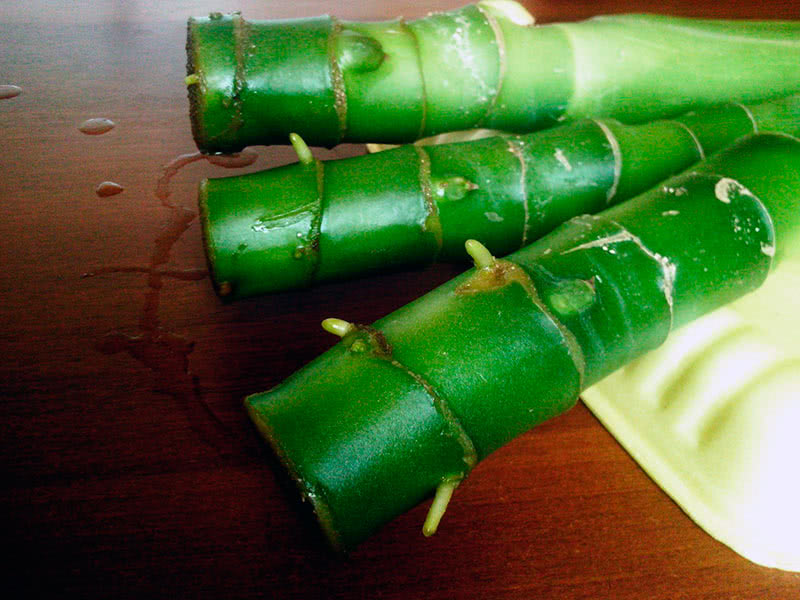
Diseases and pests during reproduction
If the necessary conditions were not met during the transplant, problems may arise:
- when the pot is chosen incorrectly, there is a high risk of root rot or growth retardation, the plant stops developing. With each transplant, the flower needs a capacity 2-3 cm larger than the previous one;
- excessive moistening of the shoots leads to the appearance of gray rot. This is a fungal disease, due to which the plant withers, sheds its leaves;
- when propagated by part of the root, it may be damaged. When decaying areas are cut off, be sure to use a sharp, sterile instrument. The damaged areas are treated with a solution of potassium permanganate or crushed activated carbon, which will prevent the spread of infection. It is also necessary to deal with any cut when propagating by cuttings, leaves;
- when the cuttings rot in water, it means that an unfiltered liquid, a dirty tool, or they are on a brightly lit window was used. It is imperative to protect young plants from sunlight.
If the cuttings also rot in the ground, it may not only be due to infection and waterlogging.Perhaps cold water is used when watering, or the plant is in a draft. Too dense soil also leads to a similar problem.
Important! It is imperative to add sand to the soil for the flower so that it allows air to pass through and is sufficiently loose. Subject to the recommendations and proper care, a beautiful evergreen plant will appear on the windowsill
Subject to the recommendations and proper care, a beautiful evergreen plant will appear on the windowsill.

Healthy young dieffenbachia
Dieffenbachia is popular among flower growers, the reproduction of which at home does not cause difficulties. There are several ways to grow a new flower. Everyone chooses the most suitable one. The easiest is reproduction by apical cuttings. Most experienced growers use the leaves, buy dieffenbachia seeds, or try to get them on their own. In any case, getting a new copy will not be difficult.
vote
Article Rating

